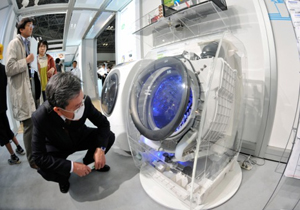Five reasons the new energy efficiency directive will not work - and what can be done to remedy this
on
Five reasons the new energy efficiency directive will not work - and what can be done to remedy this
The success of the EU's climate policy depends to a large extent on the realization of very large energy efficiency gains. It is questionable, however, whether the Energy Efficiency Directive proposed by the Commission, which the European Parliament will vote on at the end of March, will deliver the required results. Jacob Huber of the Energy Delta Institute suggests five ways to improve the Directive, and notes that it is time for Member States to start taking energy efficiency more seriously.
 |
| In 1999 the Japanese government launched the Top Runner Program, which continually ratchets up energy efficiency standards for consumer products ranging from automobiles to refrigerators and microwaves. (Photo: Forbes) |
It is well known that the EU has set itself very ambitious "decarbonisation targets". Europe wants to reduce its energy-related CO2 emissions by 85% in 2050. It is a lot less well known, however, to what extent realization of those goals depends on the successful implementation of energy savings measures.
The EU Energy Roadmap 2050, which the European Commission published in December, outlines five scenarios by which Europe could reach its emission reduction targets. In all cases the scenarios assume that the EU will use considerably less energy in 2050 than it did in 2005, to be precise between 32% and 41% less. And that's only half of the story. Since the scenarios also assume GDP growth of 1.7% a year, actual energy efficiency gains (energy use in relation to GDP) must be far higher than this.
Indeed, as this website has pointed out, to achieve such enormous gains, the EU would seem to need no less than an Apollo Program for energy efficiency. Unfortunately all it has is a draft Energy Efficiency Directive.
The good news about this draft Energy Efficiency Directive - which was published by the Commission in June, and will be voted on by the European Parliament (EP) on 28 March after a vote in the EP's subcommittee on Industry, Research and Energy (ITRE) on 28 February - is that it's there. It will be the first directive on energy efficiency ever adopted by the EU. Up to now, all Europe has had is an Energy Efficiency Action Plan, which is much more limited in scope and less concrete in action.
The bad news, though, is that the draft Directive, as many critics have observed, will not deliver the goods. Most observers (including even Philip Lowe, Director-General for Energy at the European Commission) agree that the Directive, as it stands, will not deliver the 20% energy savings target the EU has set itself for 2020 - let alone the much more ambitious longer-term goals announced in the 2050 Roadmap.
The basic problem with the draft Directive is that a number of EU member states have seriously stood on the brakes, afraid as they are of the high upfront costs and bureaucracy that a top-down energy efficiency law will involve, from their perspective. This has seriously limited the Commission's options. The European Parliament is clearly not happy with the result: MEP's have proposed more than 1800 amendments to the draft Directive, most of which are designed to step up the action. They are getting support from the new Danish EU Presidency, which has vowed to make this dossier its main priority when it comes to energy.
In my view, the critics are right to argue that the Directive in its current form will not deliver the results Europe's climate policy needs. As a contribution to the debate that is now raging, I have identified five deficiencies in the draft Directive with suggestions as to how these could be remedied.
1 Establish binding targets, they're more flexible than binding measures
The first deficiency of the draft Directive is that it fails to include binding targets. Instead, it has opted for what are called “binding measures.” These include, among others, an obligation on utilities to save 1.5% of their energy sales per year with efficiency measures, and a requirement for member states to renovate 3% of public building space per year.
This choice was made because a number of Member States have rejected binding targets. The Dutch, for instance, have complained: "The Netherlands is not in favor of an obligatory target set by the EU. Member states should be able to decide for themselves on the level of energy efficiency measures needed."
Then again, not all Member States are happy with binding measures either. As Philip Lowe has said: "The debates we’re having with member states are very interesting, because they didn't like binding targets so we gave them binding measures. They don't like binding measures and say 'We need more flexibility.' Are they going to reject this as well?"
What the recalcitrant member states apparently fail to see is that binding targets would give them much more flexibility to meet their obligations than binding measures. With binding targets, they have more freedom to choose how to achieve energy savings goals, and to adopt measures tailored to their individual context. Binding measures provide a one-size-fits-all solution for all member states, without considering their unique strengths and weaknesses.
Defining binding targets could be as simple as translating the goal for 2020 into a target (reduce primary energy consumption 20% compared to business as usual) and establishing one for 2050. The goal for 2050 should be based on the analyses performed in the EU Energy Roadmap to 2050,
| The critics are right to argue that the Directive in its current form will not deliver the results Europe's climate policy needs |
2. Make sure utilities become energy savers instead of energy sellers
The draft Directive does contain a provision requiring utilities to achieve 1.5% energy savings in the annual consumption of their customers, but unfortunately it also allows for an opt-out. It allows member states to "opt to take other measures to achieve energy savings among final consumers."
This opt-out is regrettable, because an energy savings obligation for utilities could be a very effective instrument to achieve energy efficiency. It will encourage utilities to move from a business model of selling energy to one of selling energy services. In the current model, a utility for instance sells natural gas to a consumer, which is then transformed into the service of providing a warm house with an efficiency determined by that same consumer's equipment and level of insulation. In this model the utility wants to sell the consumer as much gas as possible. It has no incentive to sell less gas. The consumer, however, is not interested in the gas as such; he only wants to warm his house at a certain temperature. If the utility were instead to sell the service of a house heated at a certain temperature, they would have every incentive to provide that level of service with the lowest consumption of gas possible. By upgrading a customer's boiler, replacing windows, and insulating and weatherizing houses, utilities could lower gas consumption while still increasing profits.
The main reason the Commission allowed for an opt-out was apparently resistance from Germany which has an alternative scheme under which the KFW Development Bank provides long-term, low interest loans for the rehabilitation or refurbishment of residential buildings. Although this scheme works quite well, it only works for those consumers who have the interest and motivation to seek energy savings measures. And it does not motivate utilities to change their business model - to become an energy-saving machine rather than an energy-selling one.
Utilities that are faced with an energy savings obligation would have to develop knowledge of efficient solutions and approaches within their organization, instead of depending on their consumers to save energy. This would work better because many consumers don't have the knowledge or motivation to pursue energy savings. For the utility it would mean that it would bring significant new competencies under its roof, such as financing energy efficiency measures and developing new efficiency solutions.
3 Establish energy efficiency standards for products and equipment
As it stands, the draft Directive does not include any regulations to address standard equipment, such as refrigerators, wash machines, cars, industrial equipment including compressors and electric
| What the recalcitrant member states apparently fail to see is that binding targets would give them much more flexibility to meet their obligations than binding measures |
One of the most successful examples of such standards is the Japanese "Top Runner" program, in place since 1998. In this program, manufacturers are obliged to surpass a weighted average value for all their products per category for each target year. The values are predetermined for each target year and the program is based on the idea that some manufacturers produce products that are more energy efficient than most products in the same category sold on the market at a given moment. This demonstrates that producing a more efficient product is technically feasible, and thus provides a sound basis for progressively increasing standards based on the most efficient "top runners".
If a manufacturer wants to introduce a product that does not meet this standard, they can do so but they have to compensate with different products in the same category that are much more energy efficient, so that on average they meet the standard. In this way, product market development is led in the right direction in terms of energy efficiency while product diversification is retained.
The Top Runner program covers 23 product categories (including cars, air conditioners, fridges, TVs, video-equipment, computers, routers, gas cooking appliances and gas water heaters). Energy savings for the products in the program ranged from 22.8-73.6% between 1999 and 2005. In the period between 1980 and 2004 the average fuel economy of the US passenger vehicle fleet increased by less than 6.5%, while (gasoline) passenger vehicles in Japan increased efficiency by 22.8% on average from 1995 to 2005 due to the Top Runner program. Between 1995 and 2004 the average efficiency of refrigerators in Japan increased by 55.2%, while in the EU efficiency increased by 40% from 1992-2005 (13 years versus 9 in Japan). It is estimated that residential energy use in Japan will have decreased by 10% in 2010 over what would have been the case, simply due to the Top Runner Program.
A similar program could be introduced in the EU for the same or additional product categories, such as standard industrial equipment.
4 Set binding targets for retrofits of existing buildings
 |
According to the Building Performance Institute Europe (BPIE), buildings represent around 40% of total final energy consumption in the EU27, and a similar proportion of CO2 emissions. Even if all new buildings are constructed to "net-zero" standards, emissions growth from the sector will only be halted, and not reduced. It is clear that the existing stock must be tackled. A modeling exercise performed by BPIE indicates that savings on the order of 70% will be required to meet climate goals.
Another lesson to come out of BPIE's modeling is that a two-step "deep" renovation process has advantages over a single stage option. This means that buildings would first be renovated in a minor or moderate manner (i.e. new windows and heating systems, with final energy savings of between 0-60%) between 2011 and 2030 and then upgraded 20 years later to deep or net-zero standards (savings of 60-90%).
The BPIE model also indicates that an average renovation rate of 2.5% needs to be achieved between the present and 2050, up from current levels of around 1%. Similar numbers are calculated by other organizations such as Renovate Europe.
The draft Directive does include an obligation to renovate 3% of public buildings a year, representing around 12% of the building stock. This is important in the initial years of a renovation ramp-up, in order to build up capacity for such renovations. However, if an average renovation level of around 2.5% is required, a target must additionally be set for the buildings sector as a whole, not just public buildings.
5 Put financing mechanisms in place
An important barrier to energy efficiency are the high upfront costs that are needed, which can have a long payback time. This makes the issue of financing crucially important, but the draft Directive does not contain any provision for the financing of energy efficiency measures. As "Green" MEP Claude Turmes recently stated: "Without the necessary financing mechanisms the measures proposed in this Directive will be wishful thinking and will not create numerous jobs and trigger innovation."
In recent years a number of innovative efficiency financing program designs have emerged in an effort to reduce upfront costs. One particularly interesting mechanism, especially in the context of transitioning to a model of selling energy services, is on-bill financing.
This means that typically a utility company pays for energy improvements in a building, which are repaid by the building owner or renter on their utility bill. In many cases customers can pay all or part of the cost of efficiency measures through the resulting saving on their bills. The cost can also be paid back in the form of a service charge paid by renters. One advantage of this method is that it gives the utility the ability to leverage the already-existing relationship with its customers.
At least 20 states in the US have implemented or are in the process of implementing on-bill financing programs and a number of barriers have been encountered including: the upfront costs utilities
| 'Without the necessary financing mechanisms the measures proposed in this Directive will be wishful thinking and will not create numerous jobs and trigger innovation' |
Long-term vision
As a final point, it should be noted that it is crucially important to look at energy efficiency in the long term, as it is a process with long-term payoffs and benefits. As the European Commission's Energy Roadmap for 2050 states: "Member States have to start now to debate how their energy mix will look like in 2050 and create a stable business investment for private investors." Only a very concrete and stable policy framework will establish the environment of certainty required for long-term efforts.
Many member states already have their own policy schemes for energy efficiency in place and are understandably reluctant to alter them. This is another area in which taking the long view will help in the process of harmonization of regulations among member states. As the 2050 Roadmap states: "Each country is responsible for its own energy choices. But they must be integrated in the overall context…" A solid policy framework in the form of the Energy Efficiency Directive will provide this context, with binding targets set at several points between now and 2050.
|
Who is Jacob Huber?
He believes that energy efficiency is important not only to meet climate goals and protect the environment, but also to reinvigorate the European economy by increasing competitiveness, producing jobs, and increasing energy security. You can respond to his article by email (huber@energydelta.nl) or by joining the thread on Syntropolis. |


 Jacob Huber is an energy analyst at the
Jacob Huber is an energy analyst at the
Discussion (0 comments)